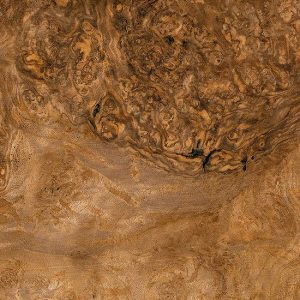The Beauty of Walnut
Walnut is a popular wood choice for kitchen cabinets, thanks to its rich, dark colors and interesting grain patterns. The fact that walnut is hard-wearing, combined with its distinctive beauty and timeless appeal, makes it one of the most requested types of cabinet material. Its gorgeous good looks complement any decor style, from farmhouse to traditional to transitional to uptown contemporary.
Walnut Appearance and Grain Color
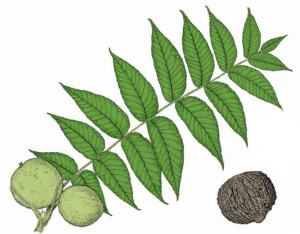
Walnut leaves and fruit from the Juglans genus
Walnut is famous for its exceptional beauty. It’s cut from the trees of the Juglans genus, a wood that was popular in the past and continues to be popular today for its strength and color.
The Walnut wood’s color will vary depending on the part of the tree from which the wood is harvested. (More on that follows.) Further, colors vary based on how the wood was dried. Kiln dried lumber that has been heat treated to speed up the drying process will result in a flat brown color. However, if the wood is allowed to air dry, then you will see a unique dark purplish color.
Heartwood and Sapwood
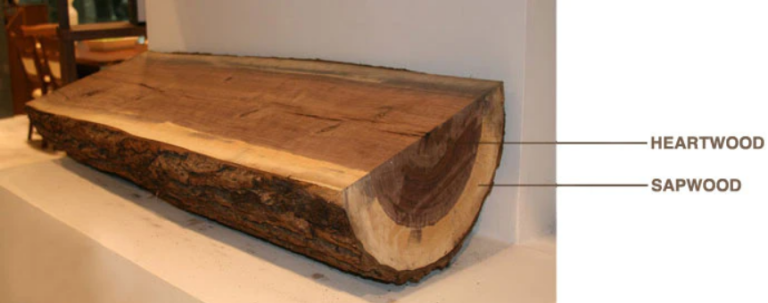
The colors found in walnut wood vary depending on what part of the tree the wood is from. Most people are familiar with walnut in its darkest state, which can be a deep chocolate or coffee color. In fact, it’s the only dark wood native to North America. However, it’s only the center of the tree that exhibits the dark colors. This is called the heartwood. Further, the heartwood may also show lighter browns, purples, grays, or reddish tints.
The outermost part of the tree is known as the sapwood because it carries the tree’s nutrients. The sapwood is typically a pale blonde color, though it can be yellow-gray as well.
Walnut Wood Grain
Black walnut trees yield consistent, straight grain lumber. In general, walnut wood is straight-grained, although it can sometimes have waves or curls which enhance its character. Crotch walnut produces a spectacular flame-like grain. Highly figured Walnut burls are prized for their unique appearance.
Eastern Black Walnut
Many varieties of walnut trees exist, but only a few are native to North America. It’s the Eastern Black Walnut (also called the American Black Walnut or American Walnut) that is most often used for woodworking. Walnut trees can grow to be 100 feet tall or more with a diameter of 30 to 40 inches, which provides a consistent grain that makes it wonderful to work with.
Are Eastern Black Walnut Trees Endangered?
Walnut trees were once abundant, but they do take more than 100 years to mature. Although not endangered, there are far fewer trees than before.
As a result, cabinet manufacturers that care about being environmentally friendly buy the wood from sustainable sources; most often from Ohio and Indiana and their neighbors.
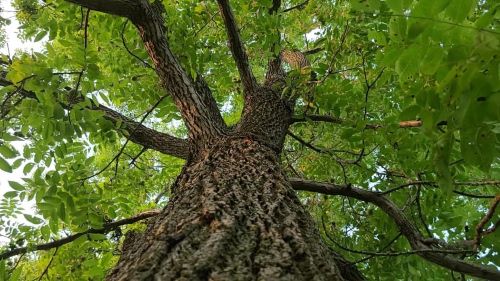
Advantages of Walnut Wood Cabinets
Modern Walnut kitchen cabinets are not just for looks. They offer many advantages to homeowners. Some of the benefits are as follows.
1. Strength and Durability
- Known for its durability
- Natural oils found in walnut yield superior scratch and dent resistance
- Able to withstand the demands of daily use in the modern kitchen
- One of the strongest woods available
- Typically more durable than Oak or Maple
- More resistant to wear than other woods
- Retains its beauty and functionality for decades
A sound investment that will provide value for years
2. Natural Beauty
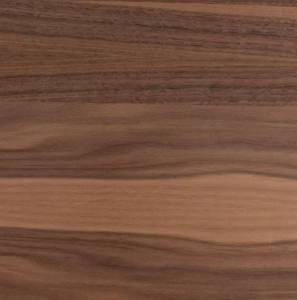
Walnut’s distinctive grain patterns and deep, rich color make up its natural beauty. Each piece of walnut is unique, showcasing variations in grain and color that add character and charm to kitchen cabinets.
3. Design Versatility
One of the best things about Walnut cabinets is their versatility in terms of design styles and finishes. Walnut wood possesses a natural beauty that complements a wide range of interior styles. Whether your clients prefer a classic, traditional, rustic, or modern look, walnut cabinets can adapt to their preferred style.
Further, walnut cabinets look great, no matter the finish color. They can be finished with a natural stain that allows the natural beauty of the deep brown color to come through and highlight its distinctive grain patterns.
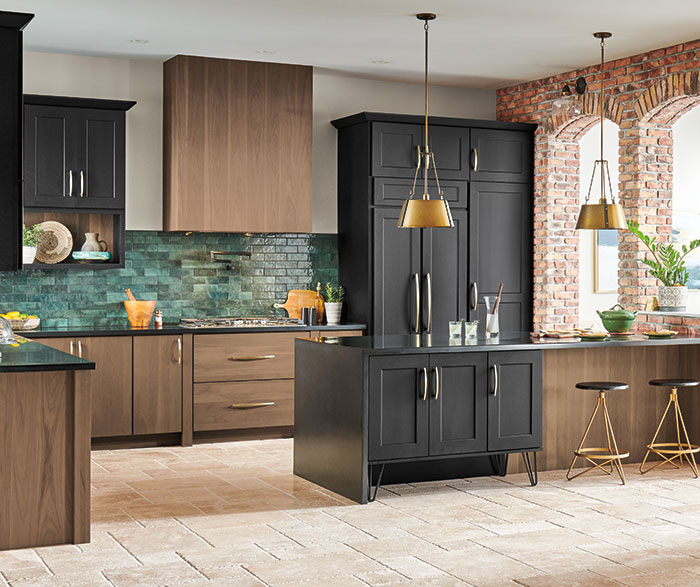
Darker stains also work well on Walnut. (See photo above) This flexibility in finishing options allows you to customize the look of your client’s cabinets so that they reflect your clients’ individual style and vision.
4. Easy to Maintain
Walnut is a hardwood known for its exceptional durability. It is highly resistant to dents and scratches, making it ideal for busy kitchens.
In addition, Walnut kitchen cabinets are easy to maintain and clean. Unlike other cabinet materials, if their surfaces get scratched, it can easily be patched and concealed using wood filler wax.
5. Sustainable and Eco-Friendly
In terms of eco-friendliness, Walnut is a great option. Walnut cabinets are an excellent choice for homeowners who would like their kitchen to feature eco-friendly products. Walnut can be naturally renewed with little impact on the environment.
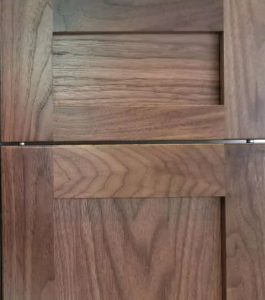
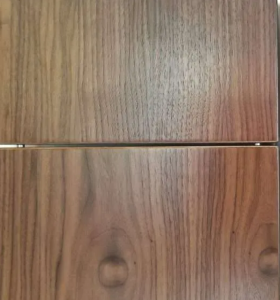
By choosing a sustainably sourced domestic variety, the wood spends less time in transit, reducing the carbon footprint.
Further, Walnut’s durability ensures a piece will last 50 or more years, whereas 10 cheap particle board pieces could be tossed in the trash in the same amount of time.
6. Improves Home Value
Walnut kitchen cabinets have a great resale value if they have been maintained and taken care of properly.
7. Looks Luxurious, Timeless and Versatile
Walnut cabinets are a great way to add style and personality to a kitchen. Walnut wood is one of the most beautiful and striking materials that exist. The stunning wood grain, as well as its deep, rich color, makes it visually pleasing.
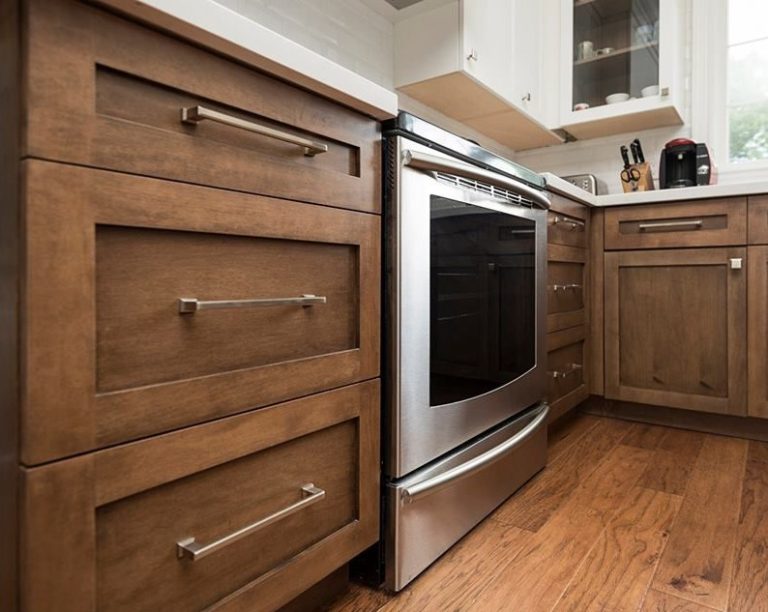
No matter the finish you and your clients choose, whether natural stained, translucent stained, even unfinished, the deep rich colors of the Walnut will be the defining feature of the kitchen. Their natural beauty is difficult – if not impossible — to duplicate with other woods.
Disadvantages of Walnut Wood Cabinets
Walnut cabinets are a great option for kitchen cabinets, but they are not without their problems. Like every other cabinet material, Walnut also has a few disadvantages.
1. Pricey
Walnut cabinets are generally more expensive compared to cabinets made from other wood species. The premium price is mostly due to the time required for the wood to mature. However, many homeowners consider the investment in walnut cabinets to be worthwhile for the unique aesthetic and durability they provide.
Although Walnut kitchen cabinets can cost more than other kinds of cabinet materials, such as plywood, particleboard, laminate, etc., veneers can be used to give the appearance without the cost.
For budget-conscious clients, you can point out that they can expect their Walnut cabinets to last up to 30 years or more with proper care and maintenance.
2. Sensitivity to Light
Walnut wood is naturally photosensitive and can lighten or darken over time when exposed to sunlight. Although not as dramatic a change as seen in Cherry or Maple, this natural aging process can result in color variations throughout the cabinets.
To minimize the impact of sunlight, advise your clients to protect their walnut cabinets by using window treatments or UV-protective coatings.
Exposure to smoke, sunlight and engineered light such as fluorescent, LED, and/or incandescent will also result in color changes.
3. Limited Stain Options
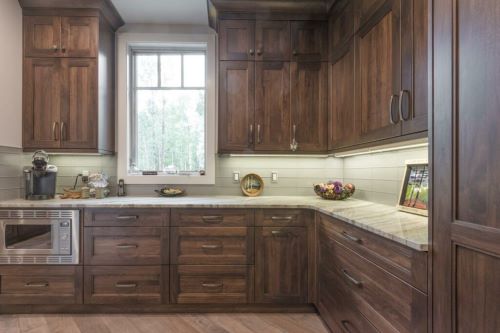
The natural dark color of Walnut makes it less receptive to staining compared to lighter wood species. While this can be an advantage for those who appreciate the natural beauty of Walnut, it limits the range of color options available for staining the cabinets.
Cabinet Built-in Accessories Available in Walnut
If a full walnut kitchen is outside your client’s budget, walnut accents, such as drawers or a kitchen island, allows them to get the beautiful Walnut they want. These accents will add warmth and depth to any room while also staying on budget.
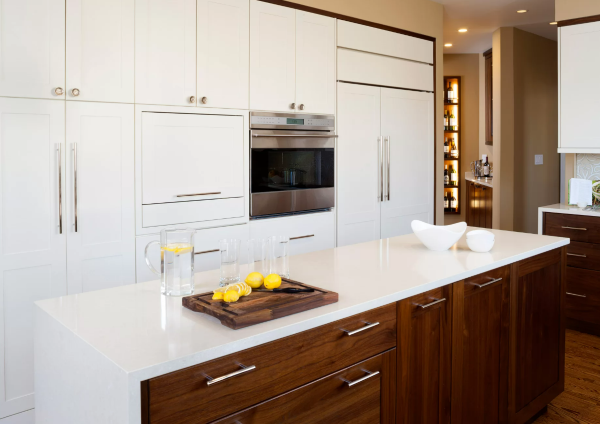
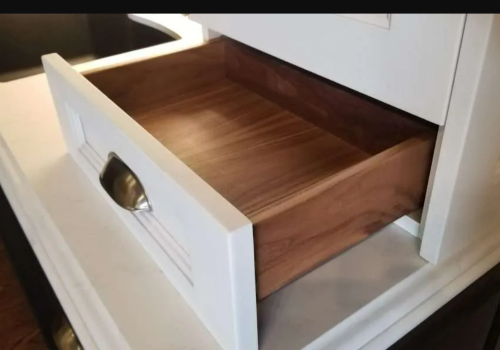
Walnut can be found in cabinets and drawers and now it can be found in built-in cabinet accessories, as well. For example, you can choose from;
- Walnut drawer boxes
- Drawer inserts for knives
- Pegboard bottom for dish storage systems
- Trays on corner pull-outs from Kessebohmer
- Flatware drawer inserts
- Hafele Fineline Magic Corner shelves
Conclusion
The natural characteristics of Walnut are unique, thus giving cabinetry character and lasting beauty. Incorporating Walnut cabinets into a kitchen design is a timeless choice that will add sophistication, warmth, and elegance. Whether it’s dark, mixed materials or Shaker-style, Walnut cabinets are a versatile choice that will always be in style.
We love that walnut comes in many variations, from light brown to medium brown to dark chocolate brown. The options are seriously endless. The variety of patterns on walnut cabinet doors have a unique look that can’t be found in any other wood choice.



